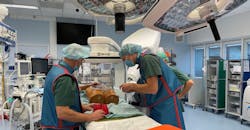AR and optical imaging collide to aid liver tumor surgery
A new optical imaging technique developed by researchers in Sweden at Chalmers University of Technology, along with surgeons at Sahlgrenska University Hospital, combines a camera and augmented reality technology to help guide surgeons performing liver tumor operations in real time (see figure and video).
Open liver tumor surgery involves opening the abdominal cavity to search for a tumor’s location in the liver. A less invasive keyhole approach that most surgeons prefer entails inserting a tiny camera through the abdominal wall into the liver, but it can be challenging.
“The current navigational process during minimally invasive resection of liver cancer is outdated,” says Carl Bodin, head of technology development at Navari Surgical, a company that continues to expand the new optical imaging technique and creates tools to help surgeons navigate cancer tumors in the liver during minimally invasive resections.
This process depends on “manual identification of image correspondences between the pre-operative medical images and the live images where the liver is deformed by pneumoperitoneum—the presence of air within the abdominal wall tissue—during the operation, which can be a challenging task,” Bodin explains.
Using the keyhole method, it can be difficult to find tumor tissue and remove it without harming healthy tissue because the liver’s shape and surface are uniform, and this procedure only captures still images for surgeons to view on a screen during the operation.
The technique by the Chalmers-Sahlgrenska team supplements the keyhole method. Surgeons use pre-operative 3D scans and algorithms they created to produce a comprehensive image of the tumor to see its exact location. This image is superimposed on a still image to serve as a real-time guide throughout the procedure.
The team’s technique is based on mapping the information from medical images onto live images inside the patient’s abdomen. It’s already been achieved for hard tissue but not yet for soft tissue, which Bodin says is the goal.
“We’re generally aiming to simplify of the surgical challenges and to increase the survival rate of patient,” he says. “We believe augmented reality-guided surgery allows for a quicker, easier, and safer operations. If this succeeds, it may accelerate the transition of minimally invasive approaches to liver cancer resections worldwide.”
About the Author
Justine Murphy
Multimedia Director, Digital Infrastructure
Justine Murphy is the multimedia director for Endeavor Business Media's Digital Infrastructure Group. She is a multiple award-winning writer and editor with more 20 years of experience in newspaper publishing as well as public relations, marketing, and communications. For nearly 10 years, she has covered all facets of the optics and photonics industry as an editor, writer, web news anchor, and podcast host for an internationally reaching magazine publishing company. Her work has earned accolades from the New England Press Association as well as the SIIA/Jesse H. Neal Awards. She received a B.A. from the Massachusetts College of Liberal Arts.

